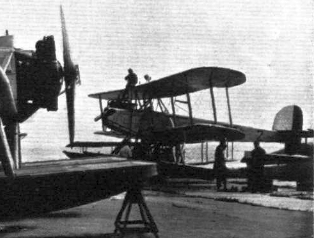Luft-Fahrzeug-Gesellschaft, also referred to as LFG, was a German aircraft manufacturer during World War I. They are best known for their various "Roland" designs, notably the Roland C.II Walfisch (whale), Roland D.II haifisch (Shark) and Roland D.VI, although they also produced a number of airships and many experimental designs.

The LFG Roland C.II, usually known as the Walfisch (Whale), was an advanced German reconnaissance aircraft of World War I. It was manufactured by Luft-Fahrzeug-Gesellschaft G.m.b.H.

The Fokker V.1 was a small German sesquiplane experimental fighter prototype built in 1916 by the Fokker-Flugzeugwerke. Sporting a parasol wing, it was the first Fokker aircraft purportedly designed by Reinhold Platz—the respective roles played by Fokker himself, Platz, and possibly others in the conceptual design of Fokker airplanes are a matter of dispute among historians—and was an early experiment in cantilever wing construction, eliminating the bracing wires typical of aircraft design at the time, something that had already been achieved with metal materials in Hugo Junkers' own pioneering Junkers J 1 in 1915.

The Bristol Gordon England biplanes were a series of early British military biplane aircraft designed by Eric Gordon England for the Bristol Aeroplane Company that first flew in 1912. Designed for easy ground transport, the aircraft could be quickly disassembled.

The Roland D.VI was a German fighter aircraft built at the end of World War I. It lost a fly-off to the Fokker D.VII, but production went ahead anyway as insurance against problems with the Fokker.

The LFG Roland D.III was a fighter aircraft produced in Germany during World War I.
The Sopwith Admiralty Types 137 and 138 were a pair of single-engine, two-seat naval biplane floatplanes, built to a British Admiralty order in 1914. They were similar in design, but having a more powerful engine the Type 138 was the larger and heavier. They were used in early torpedo dropping experiments in 1914.
The Hollandsche Vliegtuigenfabriek Avia was a two-seat biplane, designed and displayed in the Netherlands in 1918. It was advertised as a fighter or as a post and passenger aircraft. Its first flight has not been confirmed.

The Kondor D 7 was a prototype German single seat biplane fighter built over the winter of 1917-18. It was not a success and its development was soon abandoned.

The LFG Roland D.IV, later redesignated LFG Roland Dr.I was a German single engine, single seat triplane fighter flown in mid-1917. It produced no performance or operational advantages over existing types and only one was built.

The Luft-Fahrzeug-Gesellschaft (LFG) Roland D.VII was a German single seat, single engine biplane fighter aircraft built during World War I. Problems with its underdeveloped V-8 engine prevented its production.

The LFG Roland D.IX was a World War I German single seat fighter aircraft, a biplane powered by one of a new generation of powerful rotary engines. Three slightly different prototypes were built but there was no series production.

The LFG Roland D.XV was a World War I German single seat fighter aircraft, ordered as a test-bed for engine comparisons. It was distinguished from earlier Roland biplane designs by the elimination of flying wires. Two later aircraft, also called LFG Roland D.XV, were completely different designs with slab sided fuselages.

The LFG Roland G.I was a large prototype single-engine biplane bomber built in Germany in 1915, during World War I. It had a single engine buried in the fuselage driving pusher configuration propellers mounted on outriggers.

The LFG V 39 was a simple biplane trainer built in Germany in the mid-1920s. It took part in the Round Germany Flight in the summer of 1925.

The LFG V 60 was a small, single engine, tandem seat floatplane training aircraft, designed and built in Germany in the mid-1920s. About five were constructed.

The Schütte-Lanz G.I was a large, twin engine, pusher configuration, experimental biplane built in Germany early in World War I. Only one was completed.
The Schütte-Lanz D.VI was a single engine, parasol wing fighter aircraft designed and built in Germany towards the end of World War I. It had a very short career, crashing on its first flight.
The LFG V 8 Bärbel (Barbel) in English) was a small, single-engined, biplane flying boat which carried two passengers. The sole example was built in Germany shortly after World War I but was exported and used for Baltic flights.
The LFV V 18 Sassnitz was a German flying boat able to hold up to eight passengers. Only one is known to have flown.
















